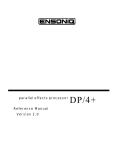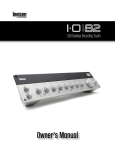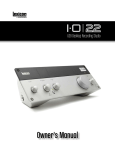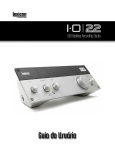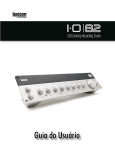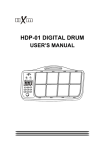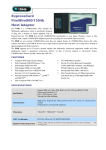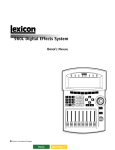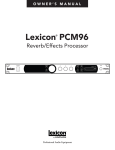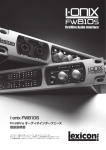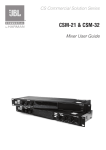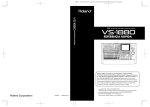Download Owner`s Manual-English
Transcript
FireWire Audio Interface with integrated channel strip processing Owner's Manual IMPORTANT SAFETY INSTRUCTIONS WARNING FOR YOUR PROTECTION READ THE FOLLOWING: KEEP THESE INSTRUCTIONS The symbols shown above are internationally accepted symbols that warn of potential hazards with electrical products. The lightning flash with arrowpoint in an equilateral triangle means that there are dangerous voltages present within the unit. The exclamation point in an equilateral triangle indicates that it is necessary for the user to refer to the owner’s manual. These symbols warn that there are no user serviceable parts inside the unit. Do not open the unit. Do not attempt to service the unit yourself. Refer all servicing to qualified personnel. Opening the chassis for any reason will void the manufacturer’s warranty. Do not get the unit wet. If liquid is spilled on the unit, shut it off immediately and take it to a dealer for service. Disconnect the unit during storms to prevent damage. Safety InStructIonS NOTICE FOR CUSTOMERS IF YOUR UNIT IS EqUIPPED WITH A POWER CORD. WARNING: THIS APPLIANCE SHALL BE CONNECTED TO A MAINS SOCKET OUTLET WITH A PROTECTIVE EARTHING CONNECTION. The cores in the mains lead are coloured in accordance with the following code: GREEN and YELLOW - Earth BLUE - Neutral BROWN - Live As colours of the cores in the mains lead of this appliance may not correspond with the coloured markings identifying the terminals in your plug, proceed as follows: • The core which is coloured green and yellow must be connected to the terminal in the plug marked with the letter E, or with the earth symbol, or coloured green, or green and yellow. • The core which is coloured blue must be connected to the terminal marked N or coloured black. • The core which is coloured brown must be connected to the terminal marked L or coloured red. This equipment may require the use of a different line cord, attachment plug, or both, depending on the available power source at installation. If the attachment plug needs to be changed, refer servicing to qualified service personnel who should refer to the table below. The green/yellow wire shall be connected directly to the units chassis. CONDUCTOR HEED ALL WARNINGS FOLLOW ALL INSTRUCTIONS THE APPARATUS SHALL NOT bE ExPOSED TO DRIPPING OR SPLASHING LIqUID AND NO ObjECT FILLED WITHI LIqUID, SUCH AS vASES, SHALL bE PLACED ON THE APPARATUS. CLEAN ONLY WITH A DRY CLOTH. DO NOT bLOCK ANY OF THE vENTILATION OPENINGS. INSTALL IN ACCORDANCE WITH THE MANUFACTURER’S INSTRUCTIONS. DO NOT INSTALL NEAR ANY HEAT SOURCES SUCH AS RADIATORS, HEAT REGISTERS, STOvES, OR OTHER APPARATUS (INCLUDING AMPLIFIERS) THAT PRODUCE HEAT. ONLY USE ATTACHMENTS/ACCESSORIES SPECIFIED bY THE MANUFACTURER. UNPLUG THIS APPARATUS DURING LIGHTNING STORMS OR WHEN UNUSED FOR LONG PERIODS OF TIME. Do not defeat the safety purpose of the polarized or grounding-type plug. A polarized plug has two blades with one wider than the other. A grounding type plug has two blades and a third grounding prong. The wide blade or third prong are provided for your safety. If the provided plug does not fit your outlet, consult an electrician for replacement of the obsolete outlet. Protect the power cord from being walked on or pinched particularly at plugs, convenience receptacles, and the point where they exit from the apparatus. Use only with the cart stand, tripod bracket, or table specified by the manufacture, or sold with the apparatus. When a cart is used, use caution when moving the cart/apparatus combination to avoid injury from tip-over. WIRE COLOR Normal Alt L LIVE BROWN N NEUTRAL BLUE BLACK WHITE E EARTH GND GREEN/YEL GREEN WARNING: If the ground is defeated, certain fault conditions in the unit or in the system to which it is connected can result in full line voltage between chassis and earth ground. Severe injury or death can then result if the chassis and earth ground are touched simultaneously. Refer all servicing to to qualified service personnel. Servicing is required when the apparatus has been damaged in any way, such as power-supply cord or plug is damaged, liquid has been spilled or objects have fallen into the apparatus, the apparatus has been exposed to rain or moisture, does not operate normally, or has been dropped. POWER ON/OFF SWITCH: The Power switch used in this piece of equipment DOES NOT break the connection from the mains. U.K. MAINS PLUG WARNING A molded mains plug that has been cut off from the cord us unsafe. Discard the mains plug at a suitable disposal facility. NEVER UNDER ANY CIRCUMSTANCES SHOULD YOU INSERT A DAMAGED OR CUT MAINS PLUG INTO A 13 AMP POWER SOCKET. Do not use the mains plug without the fuse cover in place. Replacement fuse covers can be obtained from your local retailer. Replacement fuses are 13 amps and MUST be ASTA approved to BS1362. MAINS DISCONNECT: The plug shall remain readily operable. For rack-mount or installation where plug is not accessible, an all-pole mains switch with a contact separation of at least 3 mm in each pole shall be incorporated into the electrical installation of the rack or building. FOR UNITS EqUIPPED WITH ExTERNALLY ACCESSIbLE FUSE RECEPTACLE: Replace fuse with same type and rating only. MULTIPLE-INPUT vOLTAGE: This equipment may require the use of a different line cord, attachment plug, or both, depending on the available power source at installation. Connect this equipment only to the power source indicated on the equipment rear panel. To reduce the risk of fire or electric shock, refer servicing to qualified service personnel or equivalent. If connected to 240v supply, a suitable CSA/UL certified power cord shall be used for this supply. IMPORTANT SAFETY INSTRUCTIONS DecLaratIon of conforMIty Manufacturer’s Name: Manufacturer’s Address: Lexicon Professional 8760 S. Sandy Parkway Sandy, Utah 84070, USA declares that the product: Product name: Lexicon IO FW810S Note: Product name may be suffixed by the EU. Product option: None conforms to the following Product Specifications: Safety: IEC 60065 -01+Amd 1 EMC: EN 55022:2006 EN 55024:1998 FCC Part 15 Supplementary Information: The product herewith complies with the requirements of the: Low Voltage Directive 2006/95/EC EMC Directive 2004/108/EC. RoHS Directive 2002/95/EC WEEE Directive 2002/96/EC With regard to Directive 2005/32/EC and EC Regulation 1275/2008 of 17 December 2008, this product is designed, produced, and classified as Professional Audio Equipment and thus is exempt from this Directive. Roger Johnsen Director, Engineering Signal Processing 8760 S. Sandy Parkway Sandy, Utah 84070, USA Date: February 23, 2011 European Contact: Your local Lexicon Sales and Service Office or Harman Signal Processing 8760 South Sandy Parkway Sandy, Utah 84070 USA Ph: (801) 566-8800 Fax: (801) 568-7583 eLectroMaGnetIc coMPatIBILIty This device complies with part 15 of the FCC Rules and the Product Specifications noted on the Declaration of Conformity. Operation is subject to the following two conditions: • this device may not cause harmful interference, and • this device must accept any interference received, including interference that may cause undesired operation. Operation of this unit within significant electromagnetic fields should be avoided. • use only shielded interconnecting cables. If you want to dispose this product, do not mix it with general household waste. There is a separate collection system for used electronic products in accordance with legislation that requires proper treatment, recovery and recycling. Private household in the 25 member states of the EU, in Switzerland and Norway may return their used electronic products free of charge to designated collection facilities or to a retailer (if you purchase a similar new one). For Countries not mentioned above, please contact your local authorities for a correct method of disposal. By doing so you will ensure that your disposed product undergoes the necessary treatment, recovery and recycling and thus prevent potential negative effects on the environment and human health. Service Info If you require technical support, contact Lexicon® Professional Customer Service. Be prepared to accurately describe the problem. Know the serial number of your unit, found on a sticker attached to the bottom of the IO FW810S. If you have not already taken the time to fill out your warranty registration card and send it in, please do so now. Before you return a product to the factory for service, we recommend you refer to the manual. Make sure you have correctly followed installation steps and operation procedures. If you are still unable to solve a problem, contact our Customer Service Department at (801) 568-7660 for consultation. If you need to return a product to the factory for service, you MUST contact Customer Service to obtain a Return Authorization Number. No returned products will be accepted at the factory without a Return Authorization Number. Please refer to the Warranty information on the following page, which extends to the first end-user. After expiration of the warranty, a reasonable charge will be made for parts, labor, and packing if you choose to use the factory service facility. In all cases, you are responsible for transportation charges to the factory. Lexicon Professional will pay return shipping if the unit is still under warranty. Use the original packing material if it is available. Mark the package with the name of the shipper and with these words in red: DELICATE INSTRUMENT, FRAGILE! Insure the package properly. Ship prepaid, not collect. Do not ship parcel post. Warranty This warranty is valid only for the original purchaser and only in the United States. 1. The warranty registration card that accompanies this product must be mailed (or online regisration must be completed at www.lexiconpro.com) within 30 days after purchase date to validate this warranty. Proof-of-purchase is considered to be the burden of the consumer. 2. Lexicon Professional warrants this product, when bought and used solely within the U.S., to be free from defects in materials and workmanship under normal use and service. 3. Lexicon Professional’s liability under this warranty is limited to repairing or, at our discretion, replacing defective materials that show evidence of defect, provided the product is returned to Lexicon Professional WITH RETURN AUTHORIZATION from the factory, where all parts and labor will be covered up to a period of 1 year. A Return Authorization number must be obtained from Lexicon Professional by telephone. The company shall not be liable for any consequential damage as a result of the product’s use in any circuit or assembly. 4. Lexicon Professional reserves the right to make changes in design or make additions to or improvements upon this product without incurring any obligation to install the same additions or improvements on products previously manufactured. 5. The foregoing is in lieu of all other warranties, expressed or implied, and Lexicon Professional neither assumes nor authorizes any person to assume on its behalf any obligation or liability in connection with the sale of this product. In no event shall Lexicon Professional or its dealers be liable for special or consequential damages or from any delay in the performance of this warranty due to causes beyond its control. table of contents INtRodUctIoN ................................................................... 1 Features ..........................................................................................................1 Unpacking the IO FW810S ...........................................................................2 The following items are included: .................................................................... 2 System Requirements......................................................................................2 FRoNt PANeL...................................................................... 3 ReAR PANeL ........................................................................ 4 coNNectING the Io FW810S ............................................. 5 Microphones ..................................................................................................5 Line Level Sources ..........................................................................................5 Instruments ....................................................................................................5 Computer/Digital Audio Workstation (DAW) ...............................................5 Headphones....................................................................................................5 Monitor Speakers............................................................................................5 Example Rear Panel Connections ...................................................................6 Example Rear Panel Connections ...................................................................6 the Io FW810S MIxeR - oveRvIeW .................................... 7 Installation......................................................................................................7 The Mixer – Input 1-8 Strips ........................................................................... 8 Monitor Reverbs .............................................................................................. 9 The Mixer - Balanced Out (Aux Out) Controls............................................... 10 The Mixer – Master Faders .............................................................................. 10 Channel Strip Dynamics ................................................................................. 11 Channel Strip Dynamics – Gate ...................................................................... 12 Channel Strip Dynamics – Compressor ........................................................... 12 Channel Strip Dynamics – Limiter .................................................................. 13 Channel Strip Dynamics – Gain Fader ............................................................ 14 EQ ................................................................................................................... 14 File Menu ......................................................................................................... 15 IO FW810S Control Panel .............................................................................. 16 SIGNAL FLoW dIAGRAM ..................................................... 17 SPecIFIcAtIoNS .................................................................. 19 tUtoRIAL - RecoRdING A GUItAR....................................... 21 exAMPLe PRoject - RecoRdING A GUItAR ......................... 23 Make Your Connections .................................................................................23 Connect the Guitar ................................................................................. 23 Connect the Headphones and/or Speakers.............................................. 24 Connect the Computer ........................................................................... 25 Install Drivers, Control Software, and Cubase® LE ........................................26 Set Up Windows® Audio and MIDI (Optional) .............................................. 26 The Software Mixer ........................................................................................27 Launch the Mixer Application ................................................................ 27 Set Levels ................................................................................................ 28 Add Monitor Reverb (Optional) ............................................................. 31 Set Up Cubase® LE for Use with the IO FW810S (Windows®) .....................................................................................32 Set Up Cubase® LE for Use with the IO FW810S (Mac®) .............................................................................................33 Record a Track in Cubase® LE ......................................................................... 34 Create a new project ............................................................................... 34 Start Recording ....................................................................................... 35 Listen to the Track You Just Recorded..................................................... 35 APPeNdIx ........................................................................... 37 Busses and Device Ports in Cubase® LE ........................................................... 37 Busses General Overview ........................................................................ 37 The Mixer ......................................................................................................37 Mixer General Overview ......................................................................... 37 Introduction Congratulations and thank you for purchasing the Lexicon® IO FW810S! With a wealth of features – including dbx® high-voltage, ultra low noise mic pre’s, Pantheon II reverbs, and a powerful hardware mixing board with dbx dynamics and hardware monitor reverb – the Lexicon IO FW810S is more than just an 10-in, 12-out FireWireTM audio interface. It’s a pro recording studio contained in a single rack unit. Featuring newly designed dbx® 60V high-voltage, ultra-low noise microphone preamps on every channel, the IO FW810S is more than equipped to provide professional recordings that keep your music sounding its best. The preamps run on a 60V supply to guarantee stability and provide you with a superior recording across a wide dynamic range. Performance driven A/D - D/A converters ensure pristine 24bit/96kHz audio to capture every subtle detail of your performance. And the newly updated Pantheon II plugin provides smooth, lush Lexicon reverbs for creating ideal sonic spaces. With built-in dbx Type IVTM conversion, your digital recordings will preserve their dynamic range even when levels get too high. They’ll acquire that forgiving, oversaturated quality once only found on big analog recorders. Conversion actually gives you more headroom, capturing subtle details in higher level signals instead of hard clipping them. Plus, the Lexicon IO FW810S adds onboard dbx processing (compressor, gate, limiter, and EQ) to the front end of your digital audio workstation along with a powerful hardware Mixer. The Mixer’s true-to-life interface design feels familiar from the second you start using it, making it easy to adjust levels and route signals. The mixer allows you to save and load snapshots of mixer settings, and store your own power-on default snapshot; and with it’s 12 outputs you can create up to five unique monitor mixes or mix 7.1 surround projects. When you apply the onboard dbx processing and Lexicon monitoring reverb to your input signals, the IO FW810S does the processing in real-time without taxing your CPU. With so many powerful and useful recording studio tools, it’s more than just a FireWire interface. It’s the Lexicon IO FW810S. Features • • • • • • • • • • • 8 dbx® high-voltage, ultra-low noise microphone preamps 2 front pannel input combi-jacks accept mic,line, or instrument signals 6 rear panel input combi-jack accept mic or line signals 8 analog TRS outputs (for sub-mixes) and 2 analog TRS L/R main outputs Stereo S/PDIF digital I/O MIDI in and out dbx compressor, limiter, gate, EQ, Type IV conversion processing available on all 8 analog input channels Lexicon monitor reverb; reverb sends available on all 18 software mixer channels Onboard signal processing occurs inside the FW810S, without taxing your CPU Fire Wire 400 (IEEE 1394) Audio Interface 44.1 to 96KHz sample rates, 24 bit conversion 1 Unpacking the IO FW810S The IO FW810S is shipped in one carton, containing the IO FW810S unit and a software DVD for Windows® and Macintosh® systems. After unpacking, save all the packaging materials in case you ever have to ship the unit. Thoroughly inspect the IO FW810S and packing materials for signs of damage. Report any shipment damage to the carrier that delivered the product or dealer from whom you purchased the product at once. the foLLowInG IteMS are IncLuDeD: • IO FW810S • Installer DVD containing FireWireTM drivers, this Owner's Manual, Cubase LE Owner's manual, the FW810S Mixer software, the Lexicon Pantheon II reverb plug-in, the XILS3 SE plug-in, Cubase LE Recording Software, and ToonTrack EZ Drummer Lite for Mac® and Windows® • FireWire Connector Cable • Lexicon Professional warranty registration System Requirements Powerful software for audio recording requires a powerful computer with the right operating system software, processor and memory. Most computers currently sold already meet these requirements, or can be upgraded to be compatible with the Lexicon IO FW810S. As with all such systems, adding more RAM than the minimum will allow you to do more processing and improve performance. Windows Vista, XP, 7 (Minimum System Requirements) ® • • • • • Multicore processor 1GB RAM Display Resolution 1024 x 768 pixels DVD-ROM drive Internet access required for software license activation Mac (Minimum System Requirements) ® • • • • • • Intel® Multicore processor 1 GB RAM OS X Version 10.4.9 or higher Display Resolution 1024 x 768 pixels DVD-ROM drive Internet access required for software license activation Note: Adobe Reader is required to view the pdf documents on the DVD. 2 front Panel 1 2 4 3 7 8 5 6 9 10 11 1. InPutS 1 anD 2 (MIc/InSt 1 anD MIc/InSt 2) These balanced inputs accept XLR or 1/4” connectors, and support mic, line, and instrument level sources (including guitars). 2. InStruMent Button/LeD Press when an instrument level source (such as a guitar) is connected to the corresponding input (1 or 2). The button illuminates when activated. 3. +48V Button/LeD Each of these buttons enables the phantom power to the corresponding inputs pairs. Dynamic microphones do not require phantom power to operate. Most condenser microphones do require phantom power to operate. If you are unsure about the phantom power requirements for your microphone, consult your microphone’s documentation or contact the manufacturer. This switch should be OFF if you are connecting any linelevel source to the Mic/Inst or Mic Pre jacks. 4. DynaMIcS LeDS anD InPut LeVeL LeDS The top three rows indicate what dynamics are active for each input. The bottom three rows indicate signal presence (green) and level (yellow and red) for each input. 5. fIrewIretM LeD Indicates when a FireWireTM connection is present. 6. Power LeD Indicates when the IO FW810S is turned on. 7. GaIn knoBS 1 anD 2 These knobs adjust the input gain levels for Mic/Inst 1 and Mic/Inst 2. 8. GaIn knoBS 3 – 8 These knobs adjust the input gain levels for Mic Pre 3 – 8 (the inputs located on the back panel). 9. heaDPhone outPut Jack Connect headphones here. 10. heaDPhone LeVeL knoB Adjust headphone output signal level here. 11. MaIn outPutS LeVeL knoB Adjust the main output signal level here. 3 rear Panel 1 2 3 4 5 6 7 8 1. Power SwItch Turn the IO FW810S on or off here. 2. Power Jack Standard 3-pin IEC power connector. 100-240V, 50-60Hz automatic switching to correct voltage range. 3. MIDI In anD out The MIDI jacks provide MIDI input and MIDI output to and from your computer. Connect your MIDI keyboards, sound modules, and external controllers here. 4. S/PDIf In anD out The S/PDIF in and out ports are unbalanced phono (RCA) connectors that transmit and receive either a 16-bit or 24-bit two-channel audio stream. S/PDIF ports may be found on many professional and consumer CD and digital audio recorders. It is recommended to use 75-Ohm coaxial cable for S/PDIF transfers and keep the cable length to a maximum of 10 meters to minimize interference and data dropout. 5. fIrewIretM PortS Connect FireWireTM cables here. Either port can be used, with the other acting as Thru. Note: When daisy chaining devices, connect other IO FW810S units only. Do not connect other FireWire devices to the IO FW810S. 6. BaLanceD outS 1–8 These outputs support balanced TRS or unbalanced TS ¼” connections. These outputs can be connected to a mixing board, power amplifier, powered studio monitors, recorder, or another line level input. 7. MaIn outPutS These outputs support balanced TRS or unbalanced TS ¼” connections. These outputs can be connected to a mixing board, power amplifier, powered studio monitors, recorder, or another line level input. 8. MIc/LIne InPutS 3–8 4 These balanced inputs accept XLR or 1/4” connectors, and support mic and line level sources. connecting the Io fw810S For a step-by-step example project, refer to the Tutorial at the back of this manual. Microphones Plug an XLR cable directly from a microphone into the desired Mic/Inst or Mic Pre input on the FW810S front or rear panel. If you connect a microphone to a front panel input, make sure the Instrument button/LED above the corresponding Gain knob is not lit. For example, if a microphone is connected to Mic/Inst 1, then the Instrument button/LED above the Gain 1 knob should not be lit. If your microphone requires phantom power, first make sure the microphone is connected, then press the +48V button/LED above that input pair's Gain knob. If your mics don’t need phantom power, it is best to leave it off. Note: Some microphones can be damaged by +48V phantom power. Consult your microphone's documentation before enabling +48V phantom power. Line Level Sources Line level sources include keyboards, drum machines, CD players, and external microphone preamps and effects. Plug a 1/4" TS (unbalanced) or TRS (balanced) cable directly from the line level source into the desired Mic/Inst or Mic Pre input on the FW810S front or real panel. If you connect a line level source to a front panel input, make sure the Instrument button/LED above the corresponding Gain knob is not lit. For example, if a line level source is connected to Mic/Inst 1, then the Instrument button/LED above the Gain 1 knob should not be lit. Instruments Front panel Mic/Inst jacks accept signals from instruments like electric guitars and basses. Plug a standard ¼" TS (instrument) cable directly from the instrument into one of the Mic/Inst input jacks on the front panel of FW810S. Press the Instrument button/LED above the corresponding Gain knob (Gain 1 for Mic/Inst 1, Gain 2 for Mic/Inst 2). Computer/Digital Audio Workstation (DAW) Connect your computer's FireWireTM port to the FireWire port on the IO FW810S rear panel using a standard FireWire cable (included). Headphones Connect headphones to the Headphone jack located on the front panel. The Headphone jack accepts an 1⁄4" TRS connector. Adjust headphone volume with the Headphone Level knob. Monitor Speakers Using ¼" cables, connect the L/R Main Output jacks on the rear panel to the appropriate inputs on your mixer, power amp, or powered monitors. Adjust the output volume with the Output Level knob. Additional monitor mixes may be created on outputs 1-8 using the integrated hardware digital mixer. 5 Example Front Panel Connections Example Rear Panel Connections FireWireTM Cable 6 the Io fw810S Mixer - overview The IO FW810S includes a powerful hardware Mixer with a software control panel and built-in EQ, dynamics, and monitor reverbs. When open, the Mixer controls the IO FW810S hardware. The controls are described in more detail on the following pages, and a step-by-step example project can be found in the Tutorial at the back of this manual. To turn a knob in the mixer, click and hold on a knob and move the cursor up to increase or down to decrease the parameter's value. To move a fader, click and hold on the fader and move the cursor up or down to move the fader up or down. To return a knob to its default position, double click the knob. Ctrl-click to fine adjust. Installation 1. Insert the DVD into your DVD-ROM drive. 2. The Installer should start automatically. Follow the on-screen instructions to install the software you wish to use. The Mixer is included with the Drivers and Control Software. Note: You must install the IO FW810S Drivers and Control Software to use the FW810S. If the Installer doesn't start automatically, you can start it manually by opening the approprate file on the DVD: For Mac: For Windows: Open Me InstallationMenu.exe 7 The Mixer – Input 1-8 Strips Gain Reduction Meter/Button Indicates the amount of gain reduction being applied. Click to open or close the Dynamics Control Panel (described on page 13). EQ Indicator/Button Shows the EQ line for the corresponding channel. Click to open or close the EQ (described on page 16). Stereo button Links two adjacent channels together in stereo. When linked, each strip’s controls function as a pair; when you turn one strip’s Level knob, for example, the other strip’s Level knob automatically moves as well. Pan Positions the audio in the stereo field. The top four Pan knobs control their corresponding Aux pairs. The bottom Pan knob controls the Main outs. Level Adjusts the loudness of the signal for stereo aux bus outs 1&2, 3&4, 5&6, and 7&8. Send Sends the channel’s signal to the monitor reverb (described on page 11). Mute button Silences the signal in the main mix for the selected channel (the aux and reverb levels are unaffected by this mute button). Solo button Silences all channels except this one. Note that multiple channels can be "soloed" simultaneously. Pre-Fader Input Level Meter Indicates the signal level for this channel. Fader Attenuates or adds gain to the signal in the main mix. Label (Scribble Strip) Double-click to enter a name for the channel here. 8 Monitor Reverbs The Mixer includes monitor reverb feature (also known as a "courtesy" reverb) which can be applied to and mixed in with signals passing through the Mixer. The result can be heard through the Main outs as well as through the Aux outs. Power button Turns the reverb effect on or off. Type knob Selects the desired reverb: Ambience, Chamber, SmallHall, LargeHall, Room, SmallPlate, LargePlate, VocalHall, or VocalPlate. Return knobs – Aux 1 through Aux 4 Adjusts the amount of reverb heard in the corresponding Aux out pair (when the reverb is turned on). For example, the Aux 1 Return knob increases or decreases the amount of reverb heard in Balanced Outs 1 and 2. Parameters These adjust various aspects of the reverb. Use the parameters to fine-tune reverbs to meet your needs. Pre-Delay This is a delay that’s added to the diffused signal before it enters the main part of the reverb. For all intents, it may be considered as delay that is added to the reverberated signal. It is used to temporally separate the reverb from the dry signal. Mid-RT MidRT is the mid frequency reverb time. As such, it is one of the primary controls affecting the length of the reverb tail. At low values, it models a space with absorbent walls—a signal won’t bounce many times before it dissipates. At high values, the walls are flat and extremely reflective. A signal lives a long time before dying away. Size Room Size corresponds roughly to the length of the longest wall of a rectangular room. When the room size is small, the “walls” of this space are closer together and the resultant reflection density increases. When the room size is large, that density decreases. High-Cut This parameter is a low-pass filter in the recirculating part of the reverb. It represents a frequency above which the tail dies away more quickly. Main Outs Adjusts the amount of reverb heard in the main outputs. 9 The Mixer - Balanced Out (Aux Out) Controls These controls correlate to Balanced Outs 1-8 (located on the back panel). Outs 1-2 control Balanced Outs 1 and 2, Outs 3-4 control Balanced outs 3 and 4, and so on. Labels (Scribble Strips) Double-click to assign a name to an aux pair. Level knobs Adjusts the aux pair master signal level. Meters Indicate aux pair signal level. Direct Outs buttons Enable the DAW playback streams to go directly out the corresponding outputs. For example, when Direct Out is on for Outs 1-2, only playback 1-2 will be heard on Outs 1-2. The Mixer – Master Faders Meters Indicate post-fader signal level. Master faders Attenuate or add gain to the main signal. Stereo button Links the two master faders together so their settings are always the same. Main to S/PDIF button Controls what signal is streamed out the SPDIF jack. When lit (on), the main mix is mirrored on the SPDIF jack. When not lit (off ), the DAW SPDIF Out stream is sent to the SPDIF jack. 10 Channel Strip Dynamics Inputs 1-8 in the Mixer feature Channel Strip Dynamics, including a gate, compressor, limiter, and a gain fader. To open the Channel Strip Dynamics, click the Gain Reduction meter/button at the top of the channel's "strip" in the Mixer. The gate, compresser, limiter, and gain fader are described in detail on the following pages. 11 Channel Strip Dynamics – Gate On/Off button Turns the Gate on or off. Threshold knob Sets the Threshold level. If there is any signal above the Threshold, the Gate is Open, while a signal that is lower than the Threshold is attenuated. Beware of setting the Threshold too high as it can cut off the tail end of signals as they fade out (the sustain of a guitar note, a held piano chord, a reverb tail, etc.). The Threshold is adjustable between –60 and 18 dB. Attack knob The Attack parameter sets the speed at which the Gate opens once the Threshold has been crossed. It is recommended that very fast attack times be used to catch the fronts of transient signals. The Attack parameter is adjustable between 0.1 to 200 mSec. Release knob The Release sets the rate at which the gate “closes” or attenuates once the end of the Hold time is reached. Release can be adjusted between 350 and 5 dB/Sec. Ratio knob This control determines how much the signal will be attenuated once it drops below the Threshold. This ratio works opposite from that of the compressor or limiter. If a Ratio of 1:4 is selected, a signal that is 1dB below the threshold will be reduced in gain so that it becomes 4dB below the threshold. The Ratio is adjustable between 1:1 and 1:100. Channel Strip Dynamics – Compressor On/Off button Turns the Compressor on or off. Ratio knob The Ratio is the rate at which the signal is reduced once the threshold is crossed. A 2:1 ratio means that if the incoming signal is 2dB over the threshold, the unit will compress the signal, and output a signal that only goes 1dB over the threshold. Setting the Ratio at Inf:1 makes the compressor act as a limiter. The range of the Ratio parameter is from 1:1 to 100:1. Over Easy knob OverEasy is a characteristic of dbx® Compressors and is essentially a “softknee” function that occurs at about the compression threshold. On analog dbx Compressors, OverEasy could only be turned on or off, but in the digital domain this parameter can have a range. This parameter can be adjusted between 0 and 10 where 0 corresponds to no OverEasy, and 10 corresponds to a very wide soft-knee region. To match the response of the classic dbx 160, an OverEasy of 6 is recommended. Threshold knob 12 The Threshold is the signal level at which the unit begins to compress the signal. If the level is set to -10 dBFS, then any signal larger than -10 dBFS is compressed, and any signal that has a level that is lower than -10dBFS is not. For most signals the most natural sound is achieved when most of the signal content remains just below the Threshold and only the peaks cross the Threshold. The range of the Threshold fader is -60 to +18dBFS. Auto button Auto mode dynamically sets the Attack, Hold, and Release parameters in real time, based on the incoming signal. This switch turns the Auto mode on and off. Attack knob The Attack parameter sets how quickly the compressor starts to compress the signal after it passes the threshold. The Attack can range between 0.1 mSec to 200 mSec. The Attack time is dynamically set while in Auto mode. Release knob The Release parameter is the rate at which the Compressor comes out of compression once the signal is back below the threshold and the Hold time has elapsed. Release is measured in dB per second. For example, if Release is set to 5 dB/Sec, and the signal has 10dB of gain reduction, the release time is 2 Seconds. The Release range is from 350 dB/Sec to 5 dB/Sec. The Release rate is dynamically set while in Auto mode. Hold knob The Hold parameter is the time the IO FW810S remains in compression after the signal has dropped back below the threshold. Hold is adjustable between 0 to 500 mSec and is dynamically set while in Auto mode. Channel Strip Dynamics – Limiter On/Off button Turns the Limiter on or off. Threshold knob The Threshold is the signal level at which the unit begins to limit the signal. If the level is set to -10 dBFS, then any signal larger than -10 dBFS is reduced in gain. The range of the Threshold fader is -60 to +18dBFS. Auto button This button turns Auto mode for the Limiter on and off. Auto mode dynamically sets the Limiter Attack and Release based on the input signal. Attack knob The Attack parameter sets how quickly the Limiter starts to reduce the gain of the signal after it passes the Threshold. The Attack can range between 0.1 mSec and 200 mSec. The Attack time is dynamically set while in Auto mode. Release knob The Release parameter is the rate at which the Limiter comes out of gain reduction once the signal is back below the threshold and the Hold time has elapsed. Release is measured in dB per second. For example, if Release is set to 5 dB/Sec, and the signal has 10dB of gain reduction, the release time is 2 Seconds. The Release range is from 350 dB/Sec to 5 dB/Sec. The Release rate is dynamically set while in Auto mode. 13 Hold knob The Hold parameter is the time the IO FW810S continues to reduce gain after the signal has dropped back below the threshold. Hold is adjustable between 0 and 500 mSec and is dynamically set while in Auto mode. Channel Strip Dynamics – Gain Fader This boosts or cuts the signal’s gain level, and is adjustable between 20 and –30 dB. This is a digital trim designed to be used to compensate for the gain or reduction created by the Dynamics or EQ. For example, if your compressor or limiter settings are reducing your signal level, you could increase the Gain fader to bring the level back up. Conversely, if your EQ settings are pushing levels into clipping territory, you could decrease the gain fader to lower the level. EQ Inputs 1-8 in the Mixer feature a parametric EQ where you can cut or boost selected frequency bands. You can edit parameters with the control knobs (described below), or you can click and drag the anchor points in the EQ's display (shown above). To open or close the EQ for a specific channel, click the EQ indicator/button just below the Gain Reduction meter/button for that channel. Note: To return to flat, set all knobs to 12 o’clock (double-click a knob to return it to 12 o'clock). Lo Shelf – top knob (–12 dB to 12 dB) Sets the overall gain of the low shelf frequency. Lo Shelf – bottom knob (40 Hz to 320 KHz) Selects the frequency of the low shelf. 14 Lo Mid – top knob (–12 dB to 12 dB) Sets the overall gain of the low mid frequency. Lo Mid – middle knob (160 Hz to 1280 Hz) Selects the frequency of the low mid. Lo Mid – bottom knob (.5 to 4.0) Sets the "Q" or width of the band. Hi Mid – top knob (–12 dB to 12 dB) Sets the overall gain of the high mid frequency. Hi Mid – middle knob (640 Hz to 5120 Hz) Selects the frequency of the high mid. Hi Mid – bottom knob (.5 to 4.0) Sets the "Q" or width of the band. Hi Shelf – top knob (–12 dB to 12 dB) Sets the overall gain of the high shelf frequency. Hi Shelf – bottom knob (2500 Hz to 20 KHz) Selects the frequency of the high shelf. On/Off button Turns the EQ on or off. File Menu The File menu lets you save and load snapshots. Snapshots are files (with the extension .mix) that contain settings for the Dynamics, EQ, Aux buses, pans, reverb, and levels. Open Snapshot Opens a previously saved snapshot. Save Snapshot Saves the current settings as a snapshot. If the snapshot already has been saved and named, this command will overwrite the existing snapshot. Save Snapshot As Saves the current settings as a snapshot and prompts you for a file name. Load Power-On Defaults Applies the stored power-on defaults (settings) to the IO FW810S unit. Store Power-On Defaults Saves the current snapshot settings and applies them to the IO FW810S unit each time it is turned on. You can use this to make a custom snapshot, save it as the default, and use the FW810S as a stand-alone digital mixer without a computer. Quit Closes the Mixer. 15 IO FW810S Control Panel If you're using a Mac®, you can set the Sample Rate (44.1 kHz, 48kHz, 88.2kHz, or 96kHz) and the Sync Source (Internal or SPDIF) using the Audio MIDI Setup application (located in Applications/Utilities) and your DAW. Control Panel - Windows 16 In Windows®, you can adjust these settings via the Driver Control Panel, accessed through the Start menu. In addition to the Sample Rate and Sync Source parameters, the Driver Control Panel in Windows includes a Buffer Size setting, which controls the size of audio buffers used to stream audio between the FW810S and your computer. Larger settings give you additional latency and stability. If you experience pops and clicks in the audio, try larger buffer settings. 17 18 Specifications Microphone Inputs: Input Impedance: Phantom Power: Maximum gain: E.I.N. (at max gain): Maximum Input Level: Frequency Response: THD+N: Female XLR Pin 2 Hot 3kW balanced +48 Volts +55 dB −127 dB @ 55dB gain typical (150W source) −130 dB @ 55dB gain typical A-weighted (150W source) +8 dBu +/−1.5 dB, 20Hz - 20kHz <0.02%, 20Hz - 20kHz <0.002%, 1kHz, -6 dBu Line Inputs: Input Impedance: Maximum Input Level: Frequency Response: THD+N: 1/4" TRS balanced or unbalanced 20kW balanced, 13kW unbalanced +22 dBu +/−1.5 dB, 20Hz - 20kHz <0.02%, 20Hz - 20kHz <0.002%, 1kHz, +18 dBu Instrument Input: Input Impedance: Maximum Input Level: Frequency Response: THD+N: 1/4" TS unbalanced 500kW +10 dBu +/−2.5 dB, 20Hz - 20kHz <0.08%, 1kHz, +4 dBu Line Outputs: Level: Impedance: 1/4" TRS balanced or unbalanced +20 dBu maximum 32W Balanced, 16W Unbalanced Headphone Output: 1/4" stereo jack 250mW per channel at 50W MIDI Interface: Sample Rate: 5 pin DIN connectors for MIDI in and MIDI out 44.1, 48, 88.2, or 96 kHz (determined by computer application) Dynamic Range: A/D (24 Bit) 110 dB typical, A-weighted, 20Hz 20kHz D/A (24 Bit) 110 dB typical, A-weighted, 20Hz 20kHz A/D/A (24 Bit) 108 dB typical, A-weighted, 20Hz 20kHz Power Requirements: Dimensions: Weight: 100 – 240 VAC, 50/60 Hz, 30 Watts 19”W x 1.7”H x 10.5”D 7.7 lbs. Lexicon engineers are constantly working to improve the quality of our products. Specifications are therefore subject to change without notice. 19 FireWire Audio Interface with integrated channel strip processing TUTORIAL – RECORDING A GUITAR exaMPLe ProJect - recorDInG a GuItar Welcome to the IO FW810S Tutorial. This tutorial shows you how to set up the FW810S and Cubase® LE to record a single guitar track. Follow the proceeding steps sequentially for best results. The FW810S works with many DAW applications, however this tutorial is written for use with Cubase® LE – the recording application which ships with the FW810S. Start with all cables disconnected. Enjoy. Make Your Connections Connect the Guitar 1. Turn the Gain 1 knob all the way down. Gain 1 Knob 2. Press the Instrument button, located over the Gain 1 knob, to the in position. Instrument Button/LED 3. Connect your guitar to the Mic/Inst 1 input on the front panel. 23 Connect the Headphones and/or Speakers 1. Turn the Headphone Level knob and Main Outputs Level knob all the way down. Main Outputs Level Knob Headphone Level Knob 2. If using headphones, connect your headphones to the Headphone jack. 3. If using monitor speakers, plug the speaker's amplifier or powered speakers into the Main Left and Right Outputs. 24 Connect the Computer 1. Using the provided FireWireTM cable (or equivalent), connect the FW810S to the computer's FireWireTM port. 2. Plug in the power cable and turn on the FW810S. The power switch is located on the back panel. Power Switch 25 Install Drivers, Control Software, and Cubase® LE 1. Insert the DVD into your DVD-ROM drive. The Installer should start automatically. If the Installer doesn't start automatically, you can start it manually by opening the approprate file on the DVD: Mac®: Windows®: Open Me InstallationMenu.exe 2. Once the Installer is open, follow the on-screen instructions to install the software you wish to use. Note: You must install the IO FW810S Drivers and Control Software to use the FW810S. You must also install Cubase® LE to follow the steps in this tutorial. The latest drivers can also be downloaded from www.lexiconpro.com. Set Up Windows® Audio and MIDI (Optional) When the Drivers and Control Software were installed, Windows may have automatically selected them as your default audio and MIDI outputs. This means that your Windows sounds will be sent to the FW810S rather than your computer’s sound card. If this is not desired, you can check if these have been changed and return the settings to what they were before. Windows® XP: Select Start > Control Panel > Sounds and Audio Devices > Audio Tab. Set the default recording and default playback device to your PC'S onboard sound card and click apply. Under MIDI Music Playback > Default Device, open the pull-down menu and make sure Microsoft GS Wavetable Synth is selected as the default device (XP only). Windows® Vista/7 Select Start > Control Panel > Sounds. Set the playback and record device to your PC’S onboard sound card, to do this, highlight the PC’S onboard sound card and click use default. 26 The Software Mixer Launch the Mixer Application 1. Make sure the FW810S is turned on and connected to your computer via FireWireTM. The blue FireWire LED lights when a valid FireWireTM connection is present. 2. Open the Mixer: Mac® OS: In the Applications folder, double-click IO FW810S Mixer. Windows® OS: Go to Start > All Programs > Lexicon > IO FW810S > FW810S Mixer. 3. In the Mixer, make sure the Master Faders are all the way down. Master Faders 27 Set Levels 1. Make sure the Headphone Level knob and Main Outputs Level knob are still turned all the way down on the front panel of the FW810S. 2. On the IO FW810S, turn up the Gain 1 knob to the 12 o'clock position. Gain 1 Knob 3. In the Mixer, click the Stereo button at the top of the Mixer's Input 1 and Input 2 channel strips so it is in the "out" position (light gray instead of dark gray). Stereo Button 4. Turn the Input 1 Pan knob (just above the Mute button) to the 12 o'clock position (C). Input 1 Pan Knob 28 5. Make sure the Input 1 fader is set to 0. If it is not, set it to 0. Input 1 Fader 6. Play the guitar and note the meter in the Mixer's Input 1 strip; it should be moving, indicating a signal is present. If the meter isn't indicating a signal while you play the guitar, turn up the Gain 1 knob on the IO FW810S until it does. Aim for a peak signal level which does not exceed -6 dB on the meter when the guitar is strummed. Input 1 Strip 7. Slide the Master Faders up to 0. Master Faders 29 8. Put on the headphones. While playing the guitar, gradually turn up the Headphone Level knob until you reach a comfortable listening level. If you would rather monitor the signal through the monitor speakers, turn on the powered speakers or amplifier. While playing the guitar, gradually turn up the Main Outputs Level knob until you reach the desired listening level. Do not to turn it up to the point of feedback. Main Outputs Level Knob Headphone Level Knob 30 Add Monitor Reverb (Optional) This will allow you to monitor the signal with reverb applied, but will not actually record the reverb to the audio track. 1. In the Mixer, in the Input 1 strip, turn up the Send knob to 0.00 dB. Send Knob 2. In the Reverb section. click the Power button to turn on the reverb. Reverb Power Button 3. While playing the guitar, turn up the Main Outs knob until the desired amount of reverb is reached. Main Outs Knob 31 Set Up Cubase® LE for Use with the IO FW810S (Windows®) Make sure the included FireWireTM cable is connected between your computer and FW810S, the Mixer is open, and the FW810S is turned on. Start Cubase® LE (from the Start menu under Lexicon®). If you see the warning shown below, click OK. Once you are in Cubase LE, go to Devices > Device Setup. Under Devices, click on VST Audio System and select ASIO Lexicon IO from the ASIO Driver pull-down menu if it is not already selected. Click on Switch to switch the driver, then click OK in the Device Setup dialog. You are now ready to begin recording using your FW810S and Cubase LE. 32 Set Up Cubase LE® for Use with the IO FW810S (Mac®) Make sure the included FireWireTM cable is connected between your computer and FW810S, the Mixer is open, and the FW810S is turned on. Open Cubase LE (located in the Applications folder), and go to Devices > Device Setup as shown below. Click VST Audio System, then select Lexicon IO as the ASIO Driver if it is not already selected. 4. Cubase® LE will now ask you if you would like to switch the driver. Select Switch then OK. Mac® OS 10.4.x users only: After selecting Lexicon® FW810S as the ASIO Driver, you may need to verify that your device inputs are active. To do this, follow these steps: 1. Select Device > VST Connections from the menu bar. 2. When the VST Connections panel appears, click the Inputs tab. 3. The box under the Audio Device column may say “Not Connected”. If it does, click in this box and select Lexicon IO to enable the FW810S inputs. 4. Close the VST Connections window. You are now ready to start recording with Cubase LE, described in the next section, Using the IO FW810S. 33 Record a Track in Cubase® LE Create a new project In Cubase, Click File > New Project. The New Project dialog opens. Select Lexicon IO FW810S and click OK. Select a project folder and click Choose. Add a mono track by clicking Project > Add Track > Audio. Choose the Mono configuration and click OK. should already be 5. In the Track 1 window, the Record Enable button red. If it isn't, click it so that it turns red. 1. 2. 3. 4. 6. In the Track 1 window, click the Input Monitoring button is not lit. 34 so that it Start Recording 1. Click the Record button on Cubase® LE’s Transport control. Record Button 2. Play the guitar. 3. When you are finished recording press the Stop button. Stop Button Listen to the Track You Just Recorded 1. In the Cubase® Mixer, make sure the Playback 1 fader is set to 0 dB. Note: You may need to click and hold the scrollbar at the bottom of the Mixer and slide it to the right in order to see the Playback 1 strip. 2. Press Rewind and press the Play button to listen to the track you have just recorded. Rewind and Play Buttons 35 36 aPPenDIx Busses and Device Ports in Cubase® LE In Cubase® LE, and in most Digital Audio Workstations (DAW's), the busses (the signal paths in and out of the DAW) can correspond to any of the FW810S' physical inputs and outputs (referred to as device ports in Cubase®). You can assign busses to device ports with the VST Connections dialog in Cubase® LE (Devices > VST Connections). This process is performed automatically when you create a new project using the Lexicon IO FW810S template in Cubase® LE. Also, the following general overview may be useful as well. Busses General Overview Assigning busses to device ports involves these steps: 1. In Cubase®, click Devices > VST Connections. 2. Create a bus in Cubase® (or use an existing one). 3. Select a channel within the bus (Left, Right, or Mono). 4. In the Device Port column, select a device port for the bus. Let's say, for example, that you select the bus in Cubase® LE named Stereo In - Left, and assign it to the device port named Lexicon IO 3. When you create a project and add an audio track, and you want that track to record vocals sung into a microphone (for example), you should connect the microphone to the FW810S input named Mic/Line 3. In Cubase® LE, you should set the track's input routing to Stereo In - Left. Thus, the device port (physical connection on the FW810S) is assigned to the bus (in Cubase® LE). The bus is now routed to the audio track, and the audio going to the physical connection is recorded on the audio track. The output busses work in basically the same way. Suppose you assign a device port named Lexicon IO 5 to a bus named Stereo Out - Left, and you route an audio track to that bus. The audio track's signal will be sent through the Mixer (described below) to the FW810S' Main Outs, as well as to the Balanced Out 5 on the FW810S rear panel. The Mixer In between the IO FW810S and your DAW is the IO FW810S' software Mixer, a mixing console with a graphic user interface that functions like a physical mixing console. The Mixer lets you adjust levels for individual channels, apply reverbs, dynamics and EQ to aux sends and monitor mixes – almost anything a physical mixer would allow you to do. The Mixer's controls and components are described earlier in this Owner's Manual. The following general overview may also be useful. Mixer General Overview The Mixer includes 8 Input channels (for the FW810S Mic/Inst and Mic/ Line inputs), 2 SPDIF channels (for the FW810S SPDIF In and Out), and 8 Playback channels (for signals coming from your DAW). 37 Harman 8760 South Sandy Parkway | Sandy, Utah 84070 U.S.A. Phone: (801)-568-7660 | Fax: (801) 568-7662 IO FW810S Copyright 2011 Lexicon® U.S. Patents Pending Questions or comments? Email us at: [email protected] or visit us online at www.lexiconpro.com Part# 18-0489-B














































